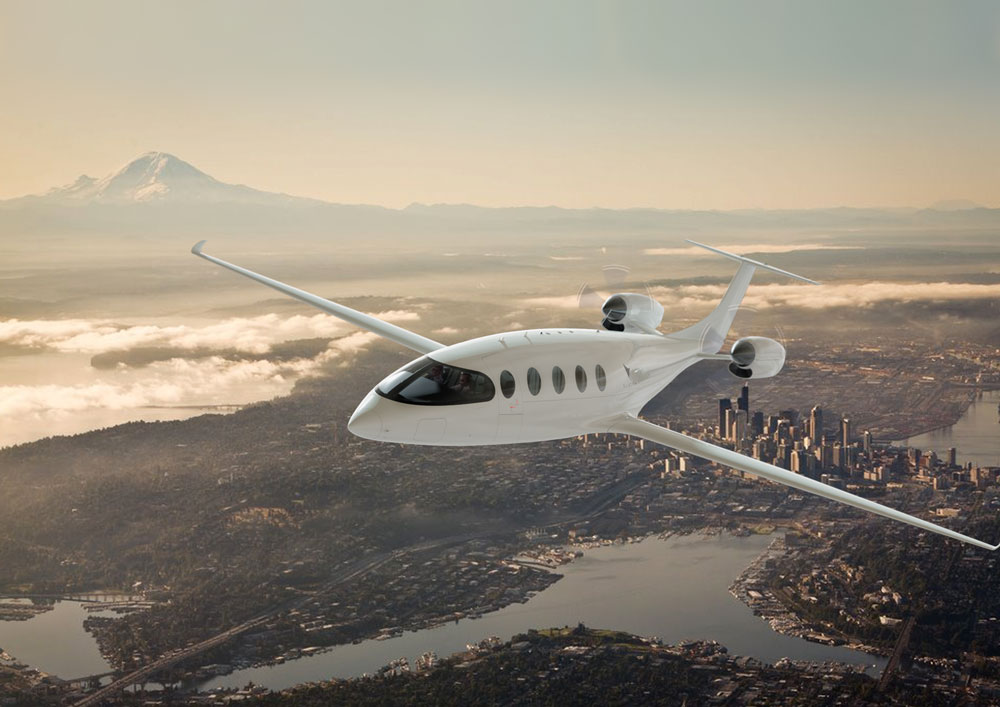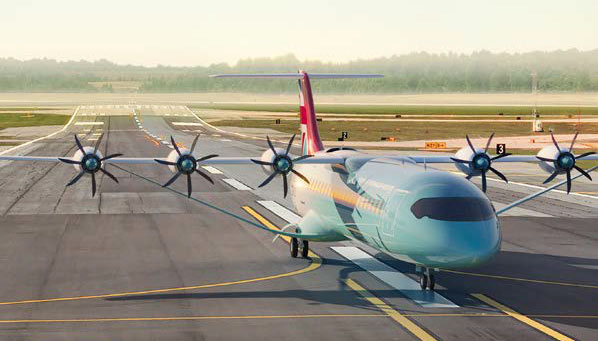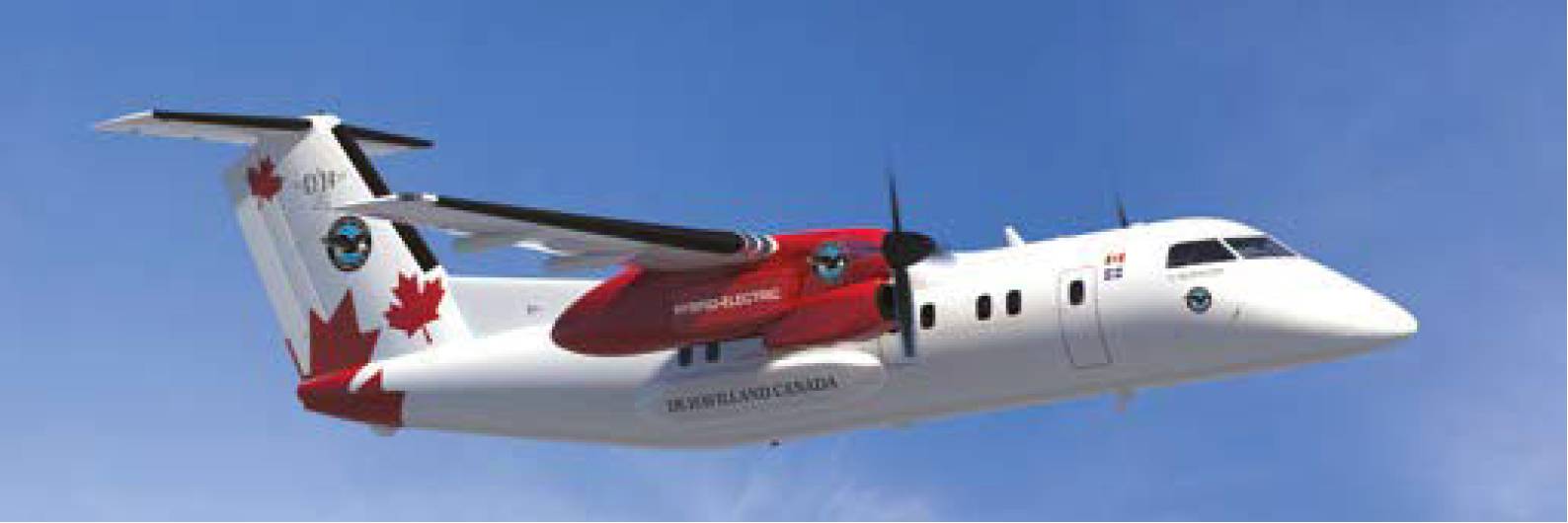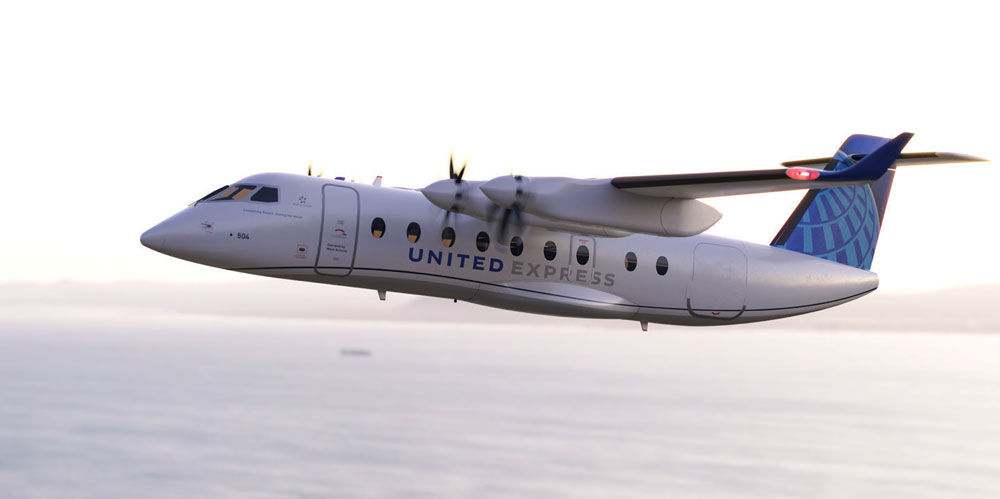AIR TRANSPORT Zero-emission regional aviation
Proving ground for electric flight
Electric and hybrid-electric aircraft will form the next wave of aviation innovation and will be a vital first step in the sector’s battle to lower its CO emission rates. However, how large can an electrically-powered airliner practically be? ALAN DRON reports.
 Eviation’s Alice is set to fly later this year. Eviation
Eviation’s Alice is set to fly later this year. Eviation
As the tsunami of pandemic-related problems starts to subside, they are being replaced by the rolling swells of ongoing efforts to cut aviation’s carbon emissions. Those swells threaten to become full-blown storms if the aviation sector cannot demonstrate to politicians and the public that it is making every effort to reduce pollution. Although aviation currently accounts for only 2.5% of total CO2 emissions, this is predicted to rise to 4% as the global airliner fleet starts to expand once more.
Although current airliners are typically 15% cleaner than their predecessors, that reduction will not be sufficient to offset growth in the number of passenger aircraft plying the air lanes.
Power
Sustainable aviation fuels (SAF), although representing an important short-term step in helping to mitigate emissions, are increasingly regarded as merely a bridge to low or zero-emission aircraft, powered by electric or hybrid-electric methods, often using hydrogen as the fuel to generate electricity.
While these propulsion methods remain, as yet, unsuitable for long-haul journeys, they could be beneficial on shorter sectors.
Airports are increasingly getting on top of the emissions problem, as ground vehicles are relatively easy to replace by battery-powered models but aircraft form a notably hard-to-decarbonise sector.
No matter how difficult it is to achieve, however, the need for cleaner methods of propulsion is critical, not only for environmental reasons, but also economic. In Europe, where the EU’s Emissions Trading System is kicking into gear, airlines by the end of this decade will face potentially crippling costs if they do not reduce the exhaust fumes emitted by their aircraft.
The future is coming
With these factors looming, a new generation of aircraft with greatly reduced or even non-existent emissions is rapidly taking shape. Technology demonstrators are already in the air and practical passenger-carrying aircraft are scheduled to be operating much sooner than would have been thought possible just a few years ago.
HYBRID-ELECTRIC TECHNOLOGY IS EXPECTED TO ACHIEVE A 30% REDUCTION IN FUEL BURN AND CO2 EMISSIONS COMPARED TO A MODERN REGIONAL TURBOPROP
Those aircraft are already starting to clock up orders. At the smaller end of the market, Singapore-owned Eviation has won orders for 12 of its Alice electrically-powered aircraft from parcels express specialist DHL Express, for delivery in 2024. Alice is planned to have a 2,500lb payload as a freighter, and can also operate as a six-passenger executive or nine-passenger commuter aircraft. Its range is 440nm and its maximum cruise is 250kt.
Moving up the size scale is Heart Aerospace’s ES-19 electric aircraft. As its designation suggests, this is a 19-seat regional or sub-regional aircraft. Readers with longer memories will recall that the 19-seater market in the US exploded following deregulation and hundreds of these aircraft, such as the Beech 1900 and BAe Jetstream 31, brought airline services to small communities in the 1980s.
As the regional affiliates of US majors gradually upgauged their aircraft over recent decades, however, services to many of those communities have dwindled.
Anders Forslund, Heart Aerospace’s founder and CEO, believes that the ES-19 can restore those grassroots services. One of the largest US regional carriers, Mesa Air Group, last summer signed a conditional order for 100 ES-19s.
“Having Mesa as a partner will be an invaluable asset for us,” Forslund said when the order was announced. “They know the business of operating 19-seaters like few others, and they bring unique operational insights that we feed directly into the design of our plane.” Mesa used to be one of the biggest operators of 19-seaters in the world.
Heart has aimed for the 19-seater category because aircraft below 20 seats are governed by the simpler Part 23 certification process.
An additional factor is that an aircraft of the ES-19’s size can use the same type of charging equipment as an electric truck, which is more affordable for small airports than installing hydrogen handling facilities.
The ES-19, which will have four battery-powered motors and a range of just over 200nm, cannot compete with a conventionally powered 19-seater on range, Forslund told AEROSPACE, “but we’re very competitive on price and we can compete on noise and emissions”.
Cruising speed will be a modest 180kt but this will not be a major problem on ultra-short sectors. Countries, such as Norway, with many such sectors, are an ideal proving ground, while Finnair has signed a letter of intent for up to 20 ES-19s.
With new technology focused on the ES-19’s powerplants, the rest of the aircraft is being constructed in as conventional a manner as possible to minimise risk. The fuselage, for example, will be aluminium, not composite. This traditional construction will have two advantages: it will help Heart meet what Forslund admits is the ‘aggressive timeline’ of first flight in 2024 and certification for commercial operations by 2026. In addition, metal will be better at shrugging off lightning strikes and accidental bumps by ground vehicles. “We’re building a workhorse aircraft and it has to be built like a tank.”
That ‘workhorse’ label will be well-deserved if the ES-19 lives up to Heart’s ambitions to get 3,000 cycles out of its batteries before replacement. The aircraft’s service life will be 20 years.
 ATI FlyZero hydrogen hybrid-electric regional 75-seat airliner concept.
ATI FlyZero hydrogen hybrid-electric regional 75-seat airliner concept.
Retrofit
Going further up the size bracket once more, another solution to bringing in more environmentally conscious aircraft is to retrofit existing types. Pratt & Whitney Canada (P&WC) and De Havilland Aircraft of Canada (DHC) have announced that they will team up to integrate hybrid-electric propulsion into a 39-seater Dash 8-100 turboprop.
Collins Aerospace will provide the electric motor and controller systems for the project, which hopes to test a demonstrator engine this year and flight-test a full hybrid-electric demonstrator in 2024.
The hybrid-electric technology is expected to achieve a 30% reduction in fuel burn and CO2 emissions, compared to a modern regional turboprop.
DHC has also announced an MoU with ZeroAvia to develop a line-fit and retrofit programme for DHC aircraft, using hydrogen-electric propulsion. “Our current focus is on taking this MoU to a full agreement, at which time we would launch the project of installing ZeroAvia’s Hydrogen Fuel Cell Powertrain onto Dash 8-400 aircraft,” said a DHC spokeswoman.
This programme will target the use of ZeroAvia’s ZA2000 2MW+ powertrain for the Dash 8-400. The intention is to identify a suitable route, utilising the aircraft and aim for entry into service within the next five years.
In October 2021, ZeroAvia announced a development collaboration with Alaska Air Group for a hydrogen-electric powertrain capable of flying 76-seat regional aircraft in excess of 500nm, starting with initial deployment into a Dash 8-400.
By the time this appears in print, ZeroAvia should have flown a 19-seat aircraft using its ZA600 powertrain in a hybrid configuration (one conventional engine, one hydrogen-electric) before flying the same aircraft using only hydrogen-electric engines later in 2022 and building to certification by 2024.
On its ZA2000 programme, ZeroAvia aims to have full thrust ground demonstrations of its 1.8MW engine variant by the end of this year. From there, the company plans certification of its ZA2000 powertrain to support 40-80 seat aircraft with a potential range in excess of 700nm by 2026, eventually extending into aircraft up to 90 seats by 2027.
“Re-engined Dash 8 aircraft will be of interest to our current customer base, as each of them will need to meet the emission targets being set by governments around the world,” said the DHC spokeswoman. “We also anticipate that re-engined Dash 8 aircraft will assist in opening up new markets, particularly ones where the Dash 8 could replace smaller jet aircraft where re-engining with sustainable propulsion technologies is not available or practicable.”
“Assuming that the technologies are proven via the demonstrator aircraft, we estimate that we could see integration onto our Dash 8 platforms from 2027 through to 2030. Our smaller aircraft would be first to introduce the new technologies due to the lesser energy requirements.”
“Some Dash 8 operators will be in a position to be (and are eager to become) early adopters and we’d like to be able to supply them with retrofit and line-fit solutions. Others, due to the nature of their operations into remote and isolated regions, will need to rely on what you deem ‘conventional’ technology for a longer time frame until the required supply infrastructure catches up.”
At the time of writing, ZeroAvia was preparing a converted Dornier 228 19-seater for flight, with new-generation engines that would give the same performance as the type’s original Garrett TPE331 turboprops.
That aircraft’s range will be limited to between 300 to 500nm, a product of the amount of hydrogen fuel it can carry while retaining the ability to seat 19 passengers, “but frankly, this is a typical distance for a 19-seater,” said Sergey Kiselev, ZeroAvia’s head of Europe.
The company is initially planning to retrofit turboprops, starting with the 19-seat category (the Dornier 228, DHC Twin Otter and Cessna Caravan are all candidates) but will then move on to larger types and develop a ‘turbocell’, with a compressor and fuel cell packed into the existing nacelles of aircraft. “We don’t see any problem up to regional jet size; after that, for narrowbodies and up you’d probably need to do significant work with airframe designers to redesign the airframe.”
That redesign would revolve around storage of the fuel and more distributed forms of propulsion. However, Kiselev is optimistic about the potential of the technology: “Frankly, we don’t see any practical limits,” he said.
He believes hybrid solutions are less attractive, as they will not achieve significant savings in terms of carbon footprint while significantly complicating the powerplant design.
 Pratt & Whitney Canada and De Havilland Aircraft of Canada are planning to install a hybrid-electric powerplant on a Dash 8-100. The reshaped nacelle is apparent in this rendering. Pratt & Whitney Canada
Pratt & Whitney Canada and De Havilland Aircraft of Canada are planning to install a hybrid-electric powerplant on a Dash 8-100. The reshaped nacelle is apparent in this rendering. Pratt & Whitney Canada
Danger, danger!
One potential problem surrounding electrical aircraft using hydrogen as a fuel source is the public perception that it is dangerous – most people have seen newsreel footage showing the fiery end of the Hindenburg airship.
Kiselev made the point that modern aircraft form a far less combustible container than the Hindenburg’s envelope and that the actual storage structures would be much more robust than in the 1930s. “Toyota has fired.45 calibre bullets through a tank to make sure it doesn’t burn or explode,” he noted.
ZeroAvia’s next design iteration will also have the hydrogen storage tanks mounted outside the airframe, so that any leak will dissipate harmlessly.
Another UK initiative pressing ahead with electric aircraft projects is FlyZero, which plans to publish aircraft concepts for regional, narrowbody (around 180 passengers) and mid-size (around 280 passengers) aircraft this month. These will be accompanied by technology roadmaps, market and economic reports and a sustainability assessment.
There is no intention to take the regional aircraft design forward to manufacturing, said Prof Simon Weeks, chief technology officer at the Aerospace Technology Institute (ATI), which is leading the ATI’s FlyZero project. Rather, the aim is to highlight the technologies that should be developed to make such aircraft a reality. “We’re identifying all the technologies and saying to government and industry: ‘We need to go and invest in this, now.’”
Some of the technologies identified in the report are seen in FlyZero’s regional aircraft concept, which could carry 75 passengers at similar speeds to today’s aircraft – typically 325kt, with a range of 800nm. Powered by liquid hydrogen stored in cryogenic fuel tanks at around –250°C in the rear fuselage, alongside the fuel cell system, an electrical distribution system takes the power to six wing-mounted propellers.
FlyZero has already identified proton exchange membrane (PEM) as a world-leading technology being developed in the UK. Hydrogen fuel and oxygen are converted into electricity through reverse electrolysis. In PEM fuel cells, hydrogen is passed through a catalyst (anode), which splits the fuel into positive ions and negative electrons. The positive ions pass through a semipermeable membrane while the negative electrons travel around an external circuit to a cathode, creating an electrical current.
 Mesa Air Group, which operates as a feeder carrier for United Airlines, has placed a conditional order for 100 of Heart Aerospace’s electric ES-19s. United Airlines
Mesa Air Group, which operates as a feeder carrier for United Airlines, has placed a conditional order for 100 of Heart Aerospace’s electric ES-19s. United Airlines
Going hydrogen
Other UK organisations involved in developing new, emissions-free aircraft are Cranfield Aerospace Solutions (CAeS) and Rolls-Royce. The former is behind Project Fresson, which should see a BrittenNorman Islander converted to hydrogen fuel cell power taking to the skies in 2023. The aircraft will be immediately recognisable by the two large hydrogen storage panniers mounted under the wings.
“Our nine-seat hydrogen fuel cell-powered B-N Islander development is a vital first step in our journey to design and manufacture larger, longer-range, regional aircraft between 19 and 100 seats,” said CAeS’s CEO, Paul Hutton.
Following successful testing, the Islander conversion will be industrialised and certified for flight. If all goes well, says CAeS, passengers could be boarding the world’s first zero-carbon passenger aircraft by 2025.
In January this year low-cost carrier easyJet announced it would work with CAeS to support the development of its hydrogen fuel cell propulsion system for commercial aircraft. The Luton-based airline will provide an operator’s perspective on the development of hydrogen propulsion.
Meanwhile, Rolls-Royce and Italian airframer Tecnam are joining forces with Norwegian airline Widerøe to deliver an all-electric commuter aircraft ready for revenue service in 2026. The project expands on a successful research programme between Rolls-Royce and Widerøe on sustainable aviation and the existing partnership between Rolls-Royce and Tecnam on powering the all-electric P-Volt aircraft.
Due to its rugged topography, which limits road and rail links in many parts of the country, Norway makes extensive use of aviation for regional connectivity and has an ambition for all domestic flights to be zero emissions by 2040. Widerøe’s network of ultra-short sectors and STOL airports on Norway’s west coast and in the far north are particularly suitable for zero-emission aircraft, said the airline’s CEO, Stein Nilsen.
Amid the excitement about the prospects of emission-free flight, some remain cautious. UK aviation consultant John Strickland believes that while regional aircraft may be a possibility within ten years, longer-haul aircraft will remain a tough problem to crack.
Even short-haul aircraft will have to cope with the weight of batteries, which remains the same throughout the flight, unlike today’s aircraft that become progressively lighter as kerosene is burned off during flight. Hydrogen, although showing great promise, will require intensive investment and will have considerable problems to overcome.
“The biggest contributor to emissions is long-haul flying and that’s the most challenging to do anything about,” he noted.
 Eviation’s Alice is set to fly later this year. Eviation
Eviation’s Alice is set to fly later this year. Eviation

